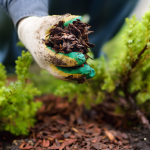Does the Plant Need Water?
Initial and consistent watering is essential for successful plant establishment. Our recommended method to
determine whether or not a plant needs water is to perform the ‘finger test’ which simply means sticking your
finger in the soil at the base of the plant to feel if it is moist.
- If the soil is moist, then watering can wait until the evening or the next day.
- If the soil is dry, then water is necessary.
How Often is Watering Typically Required?
Watering frequency depends on soil type and weather conditions. Plants installed in sandy soils require more
water than those in clay soils. Higher temperatures and sustained winds can also increase watering requirements.
New plants should receive about an inch of water per week. A rain gauge can help monitor rainfall received.
Frequency of Watering per Temp (°F) – based on lack of precipitation in average conditions
- 90°+ = Daily
- 80-90° = 4-5 days/week
- 60-80° = 2-3 days/week
- Below 60° = as necessary
Watering Techniques
Direct hand watering is the most effective method of watering. The rate at which water flows from the hose
should be a moderate trickle – too fast can wash away the mulch and disturb the soil around the base of the
plant(s). Place hose at the base of the plant and water based on the chart below. Avoid getting water on the
foliage during sunny hours of the day. The transpiration of water from the leaves can leave burn spots. It is best
to perform watering early in the morning, but evening watering is also appropriate.
Plant Type Watering Time (based on standard size plantings in average conditions)
- Trees = 2-5 minutes/each depending on size
- Shrubs = 30-45 seconds/each
- Perennials = 15-30 seconds/each
Other Tips
- A layer of mulch around new plants aids in the conservation of soil moisture and can also reduce weeds.
Finely-shredded bark mulch will also add nutrients to the soil as it breaks down. - Sprinklers, best used for turf establishment, may also be used for watering plantings; however, they are
inefficient and can damage foliage. A soaker hose or drip irrigation system may be used to help reduce
watering efforts. - Perennials can be cut back in the spring or fall. Some plants can provide winter interest and/or food for
wildlife if left over winter. Pruning of trees and shrubs should only be performed based on
recommendations of specific plants. - Straw mats are used in turf establishment to prevent erosion and help retain moisture. The netting is
rated to disintegrate within 90 days of installation and does not need to be physically removed. - Certain trees require staking upon installation. Stakes and ties should be removed after the first growing
season or they may begin to hinder the plant’s development.
For video instructions, click here to visit the site of our primary nursery supplier, Johnson’s Nursery.
These guidelines outline general best practices. Specific situations may require these guidelines to be altered.
Please contact us at (608) 821-0322 or info@carringtonlawn.com with questions or concerns.



